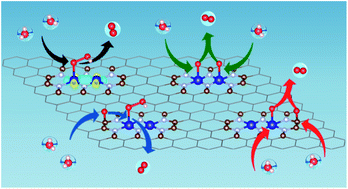Dual-metal atom incorporated N-doped graphenes as oxygen evolution reaction electrocatalysts: high activities achieved by site synergies†
Abstract
Cheap and highly efficient electrocatalysts are needed to expedite the sluggish oxygen evolution reaction (OER) in water electrolysis to provide clean and sustainable hydrogen energy. In this work, systematic first-principles calculations were conducted to investigate the detailed OER process over the popular N-doped graphenes containing low-cost single-metal atoms (MN4-gra; M = Fe, Co, Ni) and dual-metal atoms (homonuclear MMN6-gra and heteronuclear M1M2N6-gra). For the first time, two types of main reaction mechanisms with five possible reaction pathways were thoroughly considered: (1) the single-site OER occurs on a single-metal atom (M path) or on a single-carbon atom (C path); reaction intermediates transfer between a metal and a carbon atom (e.g., M–C–M or C–C–M path); (2) dual-site *O–*O coupling between two metal atoms (M–M path) or between a metal and a carbon atom (M–C path). The latter three pathways all could break the troublesome linear scaling relationships between different reaction intermediates due to the possible synergy of two catalytically active sites. Importantly, four dual-atom catalysts exhibit much lower theoretical overpotentials ηOER (M path: FeFeN6-gra 0.35 V and CoCoN6-gra 0.38 V; M–C–M (C–C–M) path: CoCoN6-gra 0.30 V, NiNiN6-gra 0.37 V, and FeCoN6-gra 0.33 V; M–M path: CoCoN6-gra 0.28 V and FeCoN6-gra 0.40 V; M–C path: FeFeN6-gra 0.33 V) than not only all the MN4-gra counterparts, but also the benchmark commercial RuO2 (ηOER: 0.47 V) and IrO2 (ηOER: 0.58 V) electrocatalysts. The origins of their superior catalytic activities are different: for the catalysts along the M path, it stems from the strong electronic regulation effect of the second metal atom on the single-atom site, whereas for those along the M–C–M (C–C–M) and M–M (M–C) ones it is ascribed to the transfer and coupling of intermediate adsorbates, respectively. All these diverse site synergies markedly alter the adsorptions of intermediates and optimize the reaction free energy profiles. The current work provides new insights into the emerging dual-atom catalysts at an atomic level, and the disclosed various reaction pathways and sophisticated synergistic effects as well as exact activity origins could help deeply understand and further design novel multi-site (electro)catalysts for wide energy application.



 Please wait while we load your content...
Please wait while we load your content...